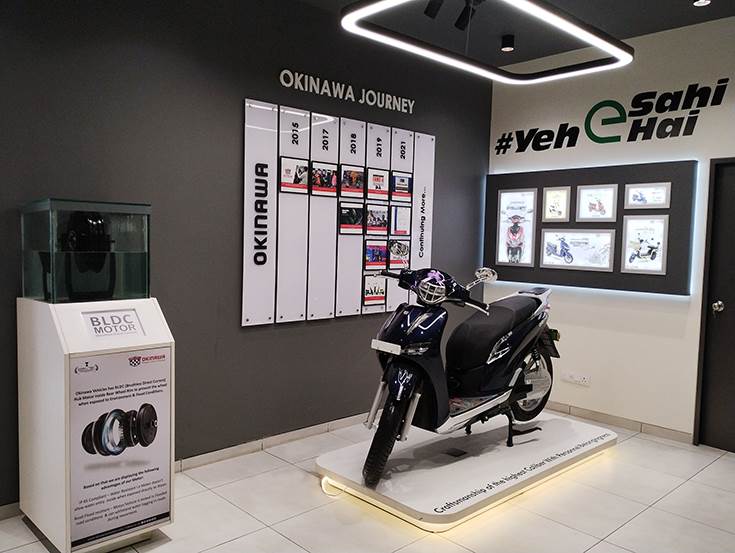As two-wheeler OEMs gear up for the festive season in India, which begins later this month, the marked uptick in their wholesale numbers for both scooters and motorcycles also reflects a mood of cautious optimism.
In the April-July 2022 period, a total of 5,105,836 two-wheelers were despatched, up 39% YoY. This comprised 16,87,062 scooters (up 73%), 3,275,256 motorcycles (up 27%) and 143,518 mopeds (up 21%). Of the nine OEMs in the fray, three – Suzuki, Hero MotorCorp and India Yamaha Motor – have ceded market share while six have increased their hold.
As per the wholesales numbers released by apex industry body SIAM, scooter market leader Honda Motorcycle & Scooter India (HMSI), the undisputed market leader, has recorded smart 78% YoY growth with 812,086 units, which gives it a market share of 48.13%, up by about two percentage point from a year ago.
Second-placed TVS Motor Co is the OEM which has made the maximum gains in market share in the first four months of this fiscal – it has increased its scooter market share to 24.18% from 20.04% in April-July 2021. In FY2022, with total sales of 866,851 scooters, TVS had a 21.62% market share. The company has doubled volumes and its despatches of 408,036 units in April-July 2022 constitute handsome 108% YoY growth.
TVS is seeing demand for all its four IC engine scooters – flagship Jupiter, NTorq, Wego and Pep+; while the Jupiter, NTorq and Wego have contributed 364,095 units (up 105% / 176,953), the Pep+ accounted for 28,913 units, up 64% / 17,598.The company’s sole electric scooter – the iQube – sees demand catapult 911% to 15,028 units from 1,486 a year ago, albeit on a low base.
TVS’ best fiscal for scooters for FY2019 when it had sold over 1.2 million units – 12,41,327 units. Will it better that score this fiscal?
A close look at the scooter market wholesales in the first four months of FY2023 reveals that of the nine OEMs in SIAM’s list, four have ceded market share – Hero MotoCorp, Suzuki, Yamaha and Piaggio.
Suzuki Motorcycle India, which has been among the movers and shakers of the scooter industry, with its Access in the past few years is seeing slower growth. The company’s 4-month sales of 221,931 units comprising the Access, Avenis and the Burgman Street, are up 30% on year-ago numbers (April-July 2021: 170,313) but it sees a decline in market share to 13.15% from 17.41% a year ago.
It’s the same with Hero MotoCorp: 104,885 units, which is a 15% uptick in demand, give it a 6.21% share, down 3% on April-July 2021’s 9.29%.
India Yamaha too is feeling the heat of the competition – 57,525 units (60%) but its share has slipped to 3.40% from 3.66% a year ago.
Piaggio at present has a 1.02% scooter market share, down a tad from the 1.21% it had a year ago. The company wholesaled 17,329 units to clock 45% YoY growth.
EV makers make their impact: Okinawa shines
Of the nine OEMs in the fray, four make electric scooters. While Okinawa Autotech and Ather only manufacture EVs, Bajaj Auto and TVS also make petrol-powered two-wheelers.

Of the four EV OEMs, Okinawa has topped with its e-scooter despatches of 42,744 units in April-July 2022, up 260% on the year-ago total of 11,888 units. This has helped the company double its share in the overall two-wheeler market to 2.53% from the 1.21% it held a year ago.
On the retail front, Okinawa is the No. 1 in the first four months of FY2023, with 35,386 units going home to buyers.
Smart e-scooter OEM Ather Energy despatched 13,265 units, which marks over 200% YoY growth and gives it a market share of 0.78%.
Bajaj Auto, which is gradually expanding its Chetak e-scooter sales network and launch plan, has clocked 9,261 units in April-July 2022, up 437%, and has a 0.54% share of the overall scooter market.

Growth outlook: Promising
With schools and colleges opening and a good portion of office goers working in hybrid mode, which calls for a two to three days in the office, demand is picking up for scooters, which are typically seen as urban mobility solutions for different members of the family.
The shift to BS VI emission norms, necessitating a technology upgrade to more expensive electronic fuel injection, has made two-wheelers costlier than they were two years ago, which has affected the bottom of the pyramid on the consumer front. This is the reason why the past two years, which were impacted by the pandemic as well as job losses, saw demand sliding for entry-level scooters and commuter motorcycles. In comparison, the executive and premium segment products were not only unaffected but also saw decent growth.
Two-wheeler consumers are inherently cost sensitive, more so when it comes to vehicle servicing. In India, the aftermarket is a vital support when it comes to aftersales of two-wheelers and the lack of diagnostics equipment for BS VI vehicles, as well as the requisite know-how, is deterring some level of buyers from making a new purchase. High petrol prices as well as the lure of electric mobility, albeit at a higher initial cost, is also drawing buyers to electric scooters. Proof of this market trend is the electric two-wheelers accounting for 3.6% of retail sales in Q1 FY2023.
All in all, the upswing in scooter demand is welcome news for OEMs, who will be keeping their fingers firmly crossed that the need to scoot on a two-wheeler grows stronger in the coming months and quarters.
ALSO READ
EVs take 3.6% of two-wheeler sales in India in H1 2022
/analysis-sales/tvs-increases-scooter-market-share-to-24–okinawa-grabs-25-92565 TVS increases scooter market share to 24%, Okinawa grabs 2.5% Honda remains undisputed market leader with 48% but TVS Motor Co makes maximum gains. EV maker Okinawa doubles its share while Suzuki, Hero MotoCorp, Yamaha and Piaggio see declines https://www.autocarpro.in/Utils/ImageResizer.ashx?n=http://img.haymarketsac.in/autocarpro/5b0ed636-a562-4716-91d5-3f9d54cca82c.jpg
